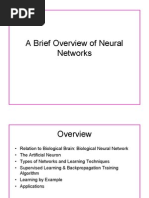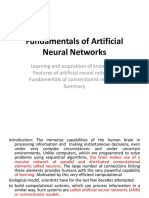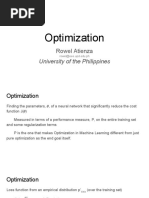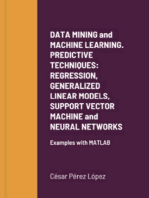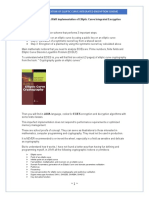0 ratings0% found this document useful (0 votes)
2 viewsArtificial neural networks-optimization
Artificial neural networks (ANN) are computational models that learn from complex data using layers of interconnected neurons. The learning process involves adjusting synaptic weights to minimize a cost function, often using optimization algorithms like gradient descent, which has limitations that advanced techniques aim to address. Techniques such as momentum, learning rate scheduling, and adaptive learning rates enhance gradient descent, with optimizers like Adam and RMSprop providing effective solutions for training neural networks.
Uploaded by
jrn.begumCopyright
© © All Rights Reserved
Available Formats
Download as DOCX, PDF, TXT or read online on Scribd
0 ratings0% found this document useful (0 votes)
2 viewsArtificial neural networks-optimization
Artificial neural networks (ANN) are computational models that learn from complex data using layers of interconnected neurons. The learning process involves adjusting synaptic weights to minimize a cost function, often using optimization algorithms like gradient descent, which has limitations that advanced techniques aim to address. Techniques such as momentum, learning rate scheduling, and adaptive learning rates enhance gradient descent, with optimizers like Adam and RMSprop providing effective solutions for training neural networks.
Uploaded by
jrn.begumCopyright
© © All Rights Reserved
Available Formats
Download as DOCX, PDF, TXT or read online on Scribd
You are on page 1/ 4
Artificial neural networks (ANN) are computational
models inspired by the functioning of the human brain,
capable of learning from complex, nonlinear data. A neural
network is composed of elementary units called neurons,
which receive input signals from other units or external
sources, process them via an activation function and
transmit them as output to other units. Neurons are
organized into layers, which can be of three types: input
layer, hidden layer and output layer. The input layer
receives the data to be analyzed, the hidden layer performs
the processing operations, and the output layer returns the
learning results. A neural network can have one or more
hidden layers, depending on its complexity.
The learning process of a neural network consists of
modifying the synaptic weights, i.e. the numerical values
that regulate the intensity of the connection between two
neurons. The goal is to minimize a cost function, which
measures the discrepancy between the desired output and
the actual output of the network. To do this, optimization
algorithms are used, which update the synaptic weights
according to the gradient of the cost function with respect to
the weights themselves. The gradient indicates the direction
and direction of the maximum slope of the function, and
therefore the opposite direction to that in which it must move
to reach the minimum. An example of an optimization
algorithm is the gradient descent (GD), which calculates
the gradient on all training data and updates the weights with
a step proportional to the negative gradient.
However, gradient descent has some disadvantages,
including:
The need to choose a fixed value for the learning
rate, which can affect the speed and quality of
convergence.
Sensitivity to data noise, which can cause
oscillations or deviations from the global minimum.
The difficulty in treating non-convex functions or
with many local minimums.
For these reasons, more advanced optimization
techniques have been developed, which we will try to
illustrate in the next paragraphs.
Techniques for improving gradient descent
In neural network optimization, there are several techniques
aimed at improving gradient descent, the fundamental
algorithm for training models. The goal is to make
convergence faster and more stable, avoiding problems such
as local minimum and gradient instability.
Some of the most common techniques to improve gradient
descent include:
Momentum: Adding a momentum term to the
weight update helps to break local lows and
accelerates convergence. The momentum term
tracks the accumulation of past gradients and
influences the current update based on this historical
information.
Learning Rate Scheduling: consists of dynamically
changing the learning rate during training. This can
be done by gradually reducing the rate of learning
over the ages or in response to certain conditions,
such as a plateau in the loss function. An example of
a scheduling algorithm is ReduceLROnPlateau,
which reduces the learning rate when model
improvement stops.
Adaptive Learning Rate: This technique adjusts the
learning rate based on the gradients calculated for
weights. For example, the AdaGrad algorithm adapts
the learning rate to each weight based on their
gradient history, reducing the rate for weights that
receive higher updates and vice versa.
Batch Normalization: Batch normalization is a
technique that normalizes the input values of each
training batch, ensuring an average of zero and a
standard deviation of one. This stabilizes data
distribution and accelerates convergence.
Weight Initialization: a correct initialization of the
weights of neurons is essential for an effective
descent of the gradient. A good practice is to select
random initializations of weights that satisfy certain
properties, such as limited variance and update
symmetry.
Optimizers :
Adam: A widely used optimizer, combining adaptive
momentum and learning rate refresh. It is effective in
most neural model training problems.
RMSprop: a useful optimizer to deal with problems
with dispersed gradients. Adapt the learning rate for
weights based on their gradient history.
SGD (Stochastic Gradient Descent): a basic
optimizer that can be effective with a properly
regulated learning rate. It is based on gradient
estimation using a random subset of the training
data.
These techniques can be combined and adapted according to
the specific needs of model training, allowing for more
efficient and stable gradient descent during neural network
optimization.
You might also like
- Comparison of Gradient Descent Algorithms On Training Neural NetworksNo ratings yetComparison of Gradient Descent Algorithms On Training Neural Networks20 pages
- A Weight Decides How Much Influence The Input Will Have On The OutputNo ratings yetA Weight Decides How Much Influence The Input Will Have On The Output1 page
- Geoffrey Hinton With Nitish Srivastava Kevin Swersky: Neural Networks For Machine LearningNo ratings yetGeoffrey Hinton With Nitish Srivastava Kevin Swersky: Neural Networks For Machine Learning31 pages
- 2022 - Neural Optimization Machine-A Neural Network Approach For OptimizationNo ratings yet2022 - Neural Optimization Machine-A Neural Network Approach For Optimization22 pages
- Cs3491-Artificial Intelligence and Machine Learning-1221091049-Unit 5 AimlNo ratings yetCs3491-Artificial Intelligence and Machine Learning-1221091049-Unit 5 Aiml38 pages
- Optimization Techniques in Deep LearningNo ratings yetOptimization Techniques in Deep Learning14 pages
- Lecture 5 - CS50's Introduction to Artificial Intelligence with PythonNo ratings yetLecture 5 - CS50's Introduction to Artificial Intelligence with Python16 pages
- Fundamentals of Artificial Neural NetworksNo ratings yetFundamentals of Artificial Neural Networks27 pages
- Part 1.1.neural Network and Training AlgorithmNo ratings yetPart 1.1.neural Network and Training Algorithm34 pages
- Optimization and Tips For Neural Network Training: Geena KimNo ratings yetOptimization and Tips For Neural Network Training: Geena Kim24 pages
- Radial Basis Networks: Fundamentals and Applications for The Activation Functions of Artificial Neural NetworksFrom EverandRadial Basis Networks: Fundamentals and Applications for The Activation Functions of Artificial Neural NetworksNo ratings yet
- DATA MINING and MACHINE LEARNING. PREDICTIVE TECHNIQUES: ENSEMBLE METHODS, BOOSTING, BAGGING, RANDOM FOREST, DECISION TREES and REGRESSION TREES.: Examples with MATLABFrom EverandDATA MINING and MACHINE LEARNING. PREDICTIVE TECHNIQUES: ENSEMBLE METHODS, BOOSTING, BAGGING, RANDOM FOREST, DECISION TREES and REGRESSION TREES.: Examples with MATLABNo ratings yet
- DATA MINING AND MACHINE LEARNING. PREDICTIVE TECHNIQUES: REGRESSION, GENERALIZED LINEAR MODELS, SUPPORT VECTOR MACHINE AND NEURAL NETWORKSFrom EverandDATA MINING AND MACHINE LEARNING. PREDICTIVE TECHNIQUES: REGRESSION, GENERALIZED LINEAR MODELS, SUPPORT VECTOR MACHINE AND NEURAL NETWORKSNo ratings yet
- Java Implementation of Elliptic Curve Integrated Encryption SchemeNo ratings yetJava Implementation of Elliptic Curve Integrated Encryption Scheme41 pages
- Solution To Test 1 (Version A) : Part I. Multiple-Choice Questions (6 2 12 Marks) DdaefaNo ratings yetSolution To Test 1 (Version A) : Part I. Multiple-Choice Questions (6 2 12 Marks) Ddaefa3 pages
- Image Processing VII Semester Elective Bca SyllabusNo ratings yetImage Processing VII Semester Elective Bca Syllabus2 pages
- Analysis of Differential Calculus in EconomicsNo ratings yetAnalysis of Differential Calculus in Economics7 pages
- Circular Motion, 2D Motion, Mechanics Revision Notes From A-Level Maths Tutor100% (2)Circular Motion, 2D Motion, Mechanics Revision Notes From A-Level Maths Tutor6 pages
- Introduction To Abstract Algebra: Samir SiksekNo ratings yetIntroduction To Abstract Algebra: Samir Siksek135 pages
- Fundamental Numerical Methods and Data Analysis 1st Edition by George Collins ISBN 9783110936001 3110936003 - Instantly access the complete ebook with just one click100% (4)Fundamental Numerical Methods and Data Analysis 1st Edition by George Collins ISBN 9783110936001 3110936003 - Instantly access the complete ebook with just one click83 pages
- Discordant Uranium-Lead Ages, I: Vol. 37, N O - 3 Transactions, American GeophysicaljunionNo ratings yetDiscordant Uranium-Lead Ages, I: Vol. 37, N O - 3 Transactions, American Geophysicaljunion7 pages
- Exercise 6 - Gap Acceptance and Priority Junction Aditya Nugroho eNo ratings yetExercise 6 - Gap Acceptance and Priority Junction Aditya Nugroho e10 pages
- Teacher Job Satisfaction the Importance of School Working Conditions and Teacher CharacteristicsNo ratings yetTeacher Job Satisfaction the Importance of School Working Conditions and Teacher Characteristics28 pages
- ELECTROMAGNETIC WAVES Class Notes Jee AdvancedNo ratings yetELECTROMAGNETIC WAVES Class Notes Jee Advanced16 pages
- Mathematical Symbols: Good Problems: March 25, 2008No ratings yetMathematical Symbols: Good Problems: March 25, 20082 pages
- Traffic Impact Assesment Practice in IndonesiaNo ratings yetTraffic Impact Assesment Practice in Indonesia6 pages
- PDE and Hypersurfaces With Prescribed Mean Curvature: Yunelsy N. AlvarezNo ratings yetPDE and Hypersurfaces With Prescribed Mean Curvature: Yunelsy N. Alvarez78 pages
- Higgs Boson Physics, Part IV: Laura ReinaNo ratings yetHiggs Boson Physics, Part IV: Laura Reina38 pages
- Margham Publications: Price List Cum Order Form For The Year 2010-2011No ratings yetMargham Publications: Price List Cum Order Form For The Year 2010-20116 pages
- ECE 553/531L (Feedback and Control System) : University VisionNo ratings yetECE 553/531L (Feedback and Control System) : University Vision3 pages
- 03 - TS - CH-3 Polynomials - Sa-1 Booklet - 2023-2024No ratings yet03 - TS - CH-3 Polynomials - Sa-1 Booklet - 2023-20249 pages
- Comparison of Gradient Descent Algorithms On Training Neural NetworksComparison of Gradient Descent Algorithms On Training Neural Networks
- A Weight Decides How Much Influence The Input Will Have On The OutputA Weight Decides How Much Influence The Input Will Have On The Output
- Geoffrey Hinton With Nitish Srivastava Kevin Swersky: Neural Networks For Machine LearningGeoffrey Hinton With Nitish Srivastava Kevin Swersky: Neural Networks For Machine Learning
- 2022 - Neural Optimization Machine-A Neural Network Approach For Optimization2022 - Neural Optimization Machine-A Neural Network Approach For Optimization
- Cs3491-Artificial Intelligence and Machine Learning-1221091049-Unit 5 AimlCs3491-Artificial Intelligence and Machine Learning-1221091049-Unit 5 Aiml
- Lecture 5 - CS50's Introduction to Artificial Intelligence with PythonLecture 5 - CS50's Introduction to Artificial Intelligence with Python
- Optimization and Tips For Neural Network Training: Geena KimOptimization and Tips For Neural Network Training: Geena Kim
- Radial Basis Networks: Fundamentals and Applications for The Activation Functions of Artificial Neural NetworksFrom EverandRadial Basis Networks: Fundamentals and Applications for The Activation Functions of Artificial Neural Networks
- DATA MINING and MACHINE LEARNING. PREDICTIVE TECHNIQUES: ENSEMBLE METHODS, BOOSTING, BAGGING, RANDOM FOREST, DECISION TREES and REGRESSION TREES.: Examples with MATLABFrom EverandDATA MINING and MACHINE LEARNING. PREDICTIVE TECHNIQUES: ENSEMBLE METHODS, BOOSTING, BAGGING, RANDOM FOREST, DECISION TREES and REGRESSION TREES.: Examples with MATLAB
- DATA MINING AND MACHINE LEARNING. PREDICTIVE TECHNIQUES: REGRESSION, GENERALIZED LINEAR MODELS, SUPPORT VECTOR MACHINE AND NEURAL NETWORKSFrom EverandDATA MINING AND MACHINE LEARNING. PREDICTIVE TECHNIQUES: REGRESSION, GENERALIZED LINEAR MODELS, SUPPORT VECTOR MACHINE AND NEURAL NETWORKS
- Java Implementation of Elliptic Curve Integrated Encryption SchemeJava Implementation of Elliptic Curve Integrated Encryption Scheme
- Solution To Test 1 (Version A) : Part I. Multiple-Choice Questions (6 2 12 Marks) DdaefaSolution To Test 1 (Version A) : Part I. Multiple-Choice Questions (6 2 12 Marks) Ddaefa
- Image Processing VII Semester Elective Bca SyllabusImage Processing VII Semester Elective Bca Syllabus
- Circular Motion, 2D Motion, Mechanics Revision Notes From A-Level Maths TutorCircular Motion, 2D Motion, Mechanics Revision Notes From A-Level Maths Tutor
- Fundamental Numerical Methods and Data Analysis 1st Edition by George Collins ISBN 9783110936001 3110936003 - Instantly access the complete ebook with just one clickFundamental Numerical Methods and Data Analysis 1st Edition by George Collins ISBN 9783110936001 3110936003 - Instantly access the complete ebook with just one click
- Discordant Uranium-Lead Ages, I: Vol. 37, N O - 3 Transactions, American GeophysicaljunionDiscordant Uranium-Lead Ages, I: Vol. 37, N O - 3 Transactions, American Geophysicaljunion
- Exercise 6 - Gap Acceptance and Priority Junction Aditya Nugroho eExercise 6 - Gap Acceptance and Priority Junction Aditya Nugroho e
- Teacher Job Satisfaction the Importance of School Working Conditions and Teacher CharacteristicsTeacher Job Satisfaction the Importance of School Working Conditions and Teacher Characteristics
- Mathematical Symbols: Good Problems: March 25, 2008Mathematical Symbols: Good Problems: March 25, 2008
- PDE and Hypersurfaces With Prescribed Mean Curvature: Yunelsy N. AlvarezPDE and Hypersurfaces With Prescribed Mean Curvature: Yunelsy N. Alvarez
- Margham Publications: Price List Cum Order Form For The Year 2010-2011Margham Publications: Price List Cum Order Form For The Year 2010-2011
- ECE 553/531L (Feedback and Control System) : University VisionECE 553/531L (Feedback and Control System) : University Vision
- 03 - TS - CH-3 Polynomials - Sa-1 Booklet - 2023-202403 - TS - CH-3 Polynomials - Sa-1 Booklet - 2023-2024





